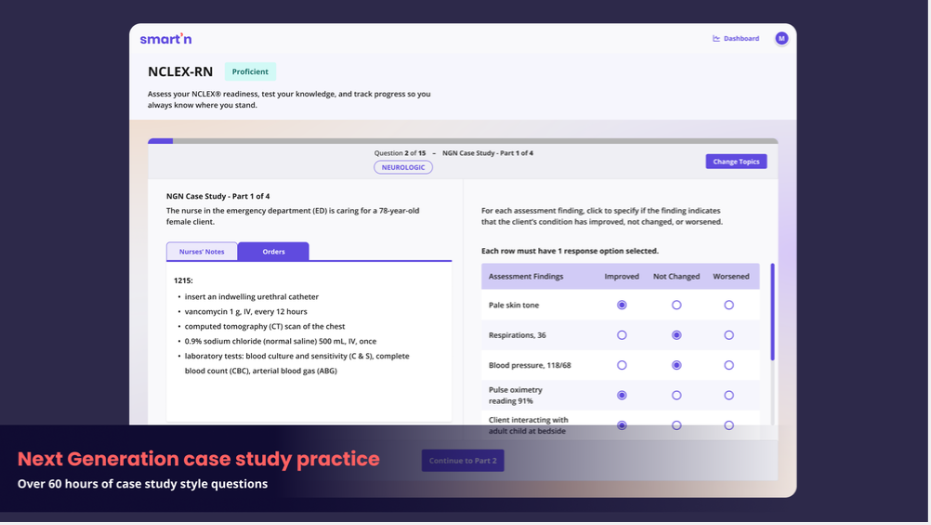ABG NCLEX Questions - 2023 Practice Test
Arterial blood gas analysis is a vital tool for understanding a patient's respiratory and metabolic status. Through the 2023 practice test, nursing students are able to uncover the mysteries of ABG interpretation, gaining the expertise needed to excel both in the NCLEX examination and in their future healthcare careers.
This article presents some ABG practice questions and their rationales, helping candidates to practice, enhance their knowledge and identify areas of strength and weakness.
We will also introduce Smart'n, a platform where you can discover thousands of NCLEX practice questions and examine your understanding. So, without further ado, let's jump right in!
ABG practice questions
Mastering ABG quizzes is crucial for nursing success. One of the best ways to get ready for NCLEX is to engage in practice questions. A leading resource for NCLEX preparation is Smart'n.
Smart'n is a dedicated NCLEX study tool crafted to support nursing students in their studies, offering an array of practice questions, detailed explanations, and assessments.
Boasting a collection of over 2,500 practice questions and more than 60 hours of NGN NCLEX-style nursing case studies, Smart'n provides concise and well-organized NextGen questions and case studies that are thoughtfully categorized by topic.
This makes it easier to focus on specific areas of nursing practice, such as respiratory, cardiac, mental health, neurological, and more.
Leveraging the question sets offered on Smart'n lets you evaluate your performance, monitor your progress, and deepen your understanding as you strive to prepare effectively for your upcoming exam.
Below are some sample arterial blood gas practice questions, along with their explanations.
Question 1:
A patient with pneumonia presents with the following arterial blood gas results: pH 7.32, PaCO2 50 mmHg, HCO3- 24 mEq/L, PaO2 80 mmHg. Which of the following imbalances is present?
a) Respiratory acidosis
b) Metabolic acidosis
c) Respiratory alkalosis
d) Metabolic alkalosis
Answer: a) Respiratory acidosis
Rationale: The pH is below the normal range (7.35-7.45), indicating acidosis. The PaCO2 is elevated (normal range: 35-45 mmHg), suggesting respiratory involvement. The HCO3- is within the normal range (22-28 mEq/L), ruling out primary metabolic acidosis. The PaO2 is slightly decreased but not significantly. The combination of low pH and high PaCO2 suggests respiratory acidosis, which may be caused by conditions like pneumonia.
Question 2:
A diabetic patient presents with the following arterial blood gas results: pH 7.25, PaCO2 32 mmHg, HCO3- 15 mEq/L, PaO2 95 mmHg. Which of the following imbalances is present?
a) Respiratory acidosis
b) Metabolic acidosis
c) Respiratory alkalosis
d) Metabolic alkalosis
Answer: b) Metabolic acidosis
Rationale: The pH is below the normal range, indicating acidosis. The PaCO2 is within the normal range, ruling out primary respiratory acidosis. The HCO3- is significantly decreased, indicating metabolic involvement. The PaO2 is also within the normal range. The combination of low pH and low HCO3- suggests metabolic acidosis, which can be seen in conditions like diabetic ketoacidosis.
Question 3:
A patient with anxiety hyperventilates and has the following arterial blood gas results: pH 7.48, PaCO2 28 mmHg, HCO3- 20 mEq/L, PaO2 100 mmHg. Which of the following imbalances is present?
a) Respiratory acidosis
b) Metabolic acidosis
c) Respiratory alkalosis
d) Metabolic alkalosis
Answer: c) Respiratory alkalosis
Rationale: The pH is above the normal range, indicating alkalosis. The PaCO2 is below the normal range, suggesting respiratory involvement. The HCO3- is slightly decreased but not significantly. The PaO2 is within the normal range. The combination of high pH and low PaCO2 indicates respiratory alkalosis, which can be caused by hyperventilation, as seen in anxiety.
Question 4:
A patient with chronic renal failure presents with the following arterial blood gas results: pH 7.38, PaCO2 48 mmHg, HCO3- 28 mEq/L, PaO2 85 mmHg. Which of the following imbalances is present?
a) Respiratory acidosis
b) Metabolic acidosis
c) Respiratory alkalosis
d) Metabolic alkalosis
Answer: a) Respiratory acidosis
Rationale: The pH is within the normal range. The PaCO2 is elevated, suggesting respiratory involvement. The HCO3- is elevated as well, but not significantly. The PaO2 is slightly decreased. The elevated PaCO2 combined with a near-normal pH suggests compensated respiratory acidosis, which can be seen in chronic conditions like renal failure.
Question 5:
A patient with excessive vomiting presents with the following arterial blood gas results: pH 7.52, PaCO2 42 mmHg, HCO3- 32 mEq/L, PaO2 95 mmHg. Which of the following imbalances is present?
a) Respiratory acidosis
b) Metabolic acidosis
c) Respiratory alkalosis
d) Metabolic alkalosis
Answer: d) Metabolic alkalosis
Rationale: The pH is above the normal range, indicating alkalosis. The PaCO2 is within the normal range, ruling out primary respiratory involvement. The HCO3- is significantly elevated, indicating metabolic involvement. The PaO2 is within the normal range. The combination of high pH and high HCO3- suggests metabolic alkalosis, which can be caused by conditions like excessive vomiting or prolonged use of diuretics.
You can find more ABG practice questions or any other types of practice questions on Smart’n.
Importance of ABG NCLEX questions
The significance of Arterial Blood Gas (ABG) NCLEX questions cannot be understated when it comes to nursing education and preparation for the licensure exam. These questions hold immense importance for several key reasons:
Clinical decision-making skills
ABG analysis is a fundamental aspect of patient assessment. Mastery of ABG concepts enables nurses to swiftly recognize and interpret acid-base imbalances, leading to more accurate diagnoses and timely interventions. By practicing ABG questions, aspiring nurses refine their ability to make critical clinical decisions under pressure.
Real-world application
Nursing is a hands-on profession, and the ability to translate theoretical knowledge into practical patient care is crucial. ABG NCLEX questions mirror real-world scenarios, helping future nurses bridge the gap between classroom learning and the complexities of the clinical setting.
Comprehensive patient assessment
ABG results offer valuable insights into a patient's respiratory and metabolic status. Understanding these results allows nurses to identify underlying conditions, assess treatment efficacy, and predict potential complications. Practicing ABG questions enhances nurses' proficiency in conducting thorough patient assessments.
Recognition of acute situations
Certain ABG imbalances can lead to life-threatening situations. Proficiency in identifying and addressing these imbalances promptly is essential for providing safe and effective care. Exposure to ABG NCLEX questions equips nurses with the skills needed to respond swiftly to emergencies.
NCLEX exam preparedness
The NCLEX is designed to evaluate a candidate's readiness to practice as an entry-level nurse. A significant portion of the exam assesses the candidate's understanding of physiological processes and their ability to apply that knowledge to clinical scenarios, including ABG interpretation. Practicing ABG questions helps candidates familiarize themselves with the type of questions they'll encounter on the NCLEX.
Conclusion
In conclusion, mastering the understanding of Arterial Blood Gas (ABG) analysis is an essential skill for any aspiring nurse preparing for the NCLEX in 2023. The ability to interpret ABG results accurately not only demonstrates your competence in assessing patient conditions but also reflects your capacity to make critical clinical decisions.
FAQs
1- What is the normal range of o2 and co2 in ABG?
Partial pressure of oxygen (PaO2): 75 to 100 millimeters of mercury (mm Hg), or 10.5 to 13.5 kilopascal (kPa)
Partial pressure of carbon dioxide (PaCO2): 38 to 42 mm Hg (5.1 to 5.6 kPa) Arterial blood pH: 7.38 to 7.42
2- What is the difference between PCO2 and CO2?
CO2 is the end product of aerobic metabolism. The level of PCO2 in venous blood indicates the overall tissue blood flow in relation to metabolic requirements.



